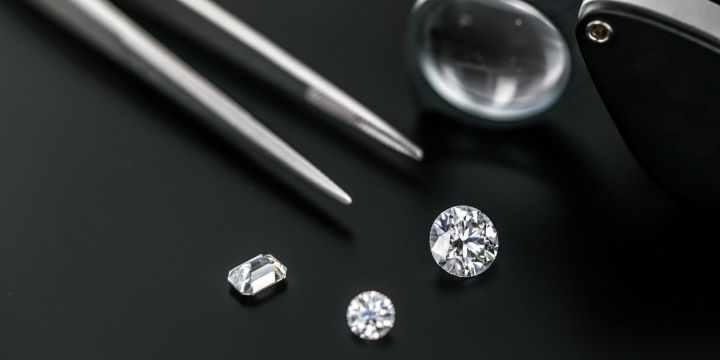Table of Contents
- Understanding Gemstone Origins
- Physical Properties: A Detailed Evaluation
- Visual Appeal and Aesthetic Differences
- Ethical and Environmental Considerations
- Pricing Structures Compared
- Lifestyle and Practicality Factors
- Investment Value and Resale Prospects
- Decoding Certification and Appraisal Processes
- The Influence of Market Innovations
- Choosing What’s Right for You
Key Takeaways
- Deep dive into the origins and notable characteristics of moissanite and diamonds.
- Insightful comparison of visual effects, practical considerations, and ecological impacts.
- Evaluation of gemstone values regarding investment, pricing, and ethical standards.
- Guidance in selection based on personal preferences and lifestyles substantiated by expert insights.
Understanding Gemstone Origins
Amidst the sparkling array of gemstones adorning jewelry cases, discerning shoppers often contemplate, “What is the essence of a real diamond?” On the other hand, curious minds may ponder the story behind an eye-catching alternative that presents a similar allure: moissanite. One might encounter mesmerizing moissanite pieces and discover a fascinating tale akin to the stars. Initially uncovered in 1893 by scientist Dr. Henri Moissan, this gemstone’s extraterrestrial origin is as captivating as its brilliance – drawing a connection to the vast cosmos. The story starkly contrasts with diamonds, born from Earth’s mantle through ages of extreme pressure and heat.
To compare these two captivating gemstones comprehensively, one could start by exploring their Earth-bound and celestial beginnings. Languages of luxury and romanticism often surround the narrative of diamonds, citing their formation deep within the terrestrial realm millions of years ago. Meanwhile, moissanite’s stellar genesis is a riveting reminder of the universe’s gifts to humanity. To fully understand the question, is moissanite a real diamond? One must first appreciate their distinct births, as these origins lay the foundation for their respective properties, aesthetics, and values. Enriching oneself with the knowledge of their origins instills an appreciation for nature’s artistry and enables informed decision-making when choosing between them.
Physical Properties: A Detailed Evaluation
Delving deeper into the comparison, one must consider the intricate physical properties that define moissanite and diamonds. According to the Mohs Hardness Scale, diamonds are the most complex material known to man, scoring a perfect ten. As the hardest known natural material, a diamond’s formidable structure ensures that it is virtually immune to scratches, contributing to its longevity and enduring value. While slightly softer, moissanite still impresses with a remarkable hardness that makes it second only to diamond, manifesting admirable resilience for jewelry expected to withstand the vagaries of daily life.
Further, moissanite’s higher refractive index bestows upon it a spectacular display known as “fire”— the dispersion of light into rainbow colors, more pronounced than in diamonds. The distinct allure of moissanite emanates from its fiery sparkle and may captivate those seeking a stone with animated brilliance. In contrast, a diamond’s allure is its classic, unadulterated sparkle, a timeless symbol of elegance. This comparison extends beyond mere aesthetics, touching upon functional considerations like durability and scratch resistance, integral for pieces intended for everyday adornment or to mark significant life milestones.
Visual Appeal and Aesthetic Differences
The enchanting dance of light within a gemstone often acts as the primary draw for admirers of fine jewelry. Diamonds are traditionally celebrated for their resplendently clear appearance, often perceived as the pinnacle of luxury. The Gemological Institute of America (GIA) has developed a sophisticated color grading system that allows diamonds to range from utterly colorless to slightly tinted. This scale is a testament to the nuanced and sophisticated approach to evaluating diamonds, helping to establish a universal language for its aesthetic valuation.
Moissanite’s unique visual character reveals itself differently under the orchestration of light, presenting hues that typically fall within the near-colorless range of the GIA scale. Such a distinctive sparkle often leads to its comparison with the enchanting K grade of diamonds – an insightful point of reference for potential buyers to visualize a moissanite’s visual impact. Furthermore, the cutting process enhances each stone’s inherent beauty; diamond cuts are crafted to maximize brilliance, while moissanite cuts aim to augment its signature fire. Selecting the right cut style can significantly influence the overall appearance of the gemstone, thereby lifting its aesthetic appeal and aligning it with personal tastes.
Ethical and Environmental Considerations
In the realm of gemstones, beauty goes much deeper than mere appearance. The ethical and ecological footprints left by the sourcing and creation of these stones have become a point of intense scrutiny and debate. While rich with tradition, the diamond industry faces criticism over the mining practices—ranging from ecological disruption to concerns over labor conditions. It has propelled a concerted effort toward responsible sourcing protocols, comprehensive traceability, and stringent certification standards.
On the flip side, the production of moissanite presents itself as a less contentious choice from an ethical standpoint. Lab-created by harnessing advanced technologies, moissanite avoids many environmental pitfalls associated with traditional mining. For the growing cohort of socially responsible consumers, the sustainable production of moissanite represents a step towards conscious consumerism. The promise of transparency and accountability from moissanite producers sets the standard for an industry more attuned to contemporary values and the health of our planet.
Pricing Structures Compared
Cost often plays a defining role among the many facets influencing a buyer’s decision. The pricing of both diamonds and moissanite reflects a multifaceted equation, factoring in rarity, demand, and the intrinsic qualities of each stone. Diamonds have long been the benchmark of high-value gemstones—coveted for their natural scarcity and deeply ingrained cultural symbolism. Often positioned as the more budget-friendly contender, moissanite embodies exceptional brilliance at a fraction of the cost, challenging the notion that luxury must always come at a premium.
Moissanite’s enticing price point doesn’t diminish its desirability; instead, it broadens the accessibility of owning a shining, durable gemstone. Considering moissanite’s competitive pricing, one may achieve remarkable savings without forgoing the aesthetic pleasure of a captivating jewel. It is a gesture towards embracing the beauty that gemstones bring to our lives while maintaining financial prudence. With moissanite, a wider audience may indulge in the joy of owning an eye-catching piece that rivals the traditional diamond in many respects yet remains attainable.
Lifestyle and Practicality Factors
Beyond aesthetics and pricing, practical implications are significant in the decision-making process. The projection of personal style through jewelry must align harmoniously with one’s daily routine. Like diamonds, moissanite’s robustness and scratch resistance provide convenience and peace of mind for active lifestyles without the constant concern for potential damage.
In addition, both stones call for a relatively straightforward maintenance routine to preserve their luster. Regular cleaning with gentle solutions will keep these gems sparkling like new. Moissanite’s resistance to tarnishing and its ability to withstand exposure to everyday elements make it a joy for individuals seeking elegance and practicality. The practicality of owning a moissanite or diamond piece thus aligns superbly with the desire for minimal upkeep, durability, and continuous charm.
Investment Value and Resale Prospects
When acquiring gemstones, many keenly consider their investment potential. Diamonds have enjoyed the reputation of holding value steadfastly over time, often seen as a tangible manifestation of wealth preservation. The market for diamond resale, backed by its time-honored prestige, often reflects stable valuations, albeit subject to fluctuations influenced by various economic conditions.
Moissanite, by contrast, is emerging as a strong player within the investment domain. Its minimal depreciation can offer reassurance for those considering the long-term implications of their purchase. Yet, its value extends beyond just economics; the decision to invest in moissanite is also an investment in sustainability and modern innovation—a point resonating deeply with contemporary mindsets. These dynamics articulate the evolving perceptions of value within gemstone markets, where subjective appeal and objective worth amalgamate to inform potent investment pathways.
Decoding Certification and Appraisal Processes
Certifications and appraisals form the cornerstone of trust and verification in the world of gemstones. These processes validate a stone’s authenticity, protecting the consumer’s investment. Diamond certifications are particularly meticulous, encompassing a comprehensive analysis of the 4 Cs, supplemented by additional factors like fluorescence and symmetry. Renowned institutions like the GIA and AGS provide these essential services, allowing for based on established industry standards.
Just as meticulously, moissanite is subject to rigorous quality assessments. Advanced gemological techniques ascertain each stone’s quality, cut, and clarity, enabling buyers to approach their purchases confidently. The approach to moissanite certification parallels that of diamonds, underscoring a commitment to reliability and transparency. With the clear presentation of a stone’s credentials, diamonds and moissanite demonstrate a shared dedication to upholding quality and instilling buyer assurance.
The Influence of Market Innovations
Technological innovation and consumer demand continually reshape the jewelry industry’s landscape. Breakthroughs in creating lab-grown diamonds are transforming notions of availability and attainability. Insights from GIA’s comprehensive research indicate a trajectory towards higher quality and greater affordability in synthetic diamond production. Similarly, moissanite has undergone a journey from its stellar origins to its contemporary embrace as a cherished gemstone, with ongoing enhancements in manufacturing techniques uplifting its allure.
These advancements signal a future ripe with potential for both gems regarding quality and consumer reach. As preferences evolve and awareness grows, these market innovations ensure that the beauty of gemstones remains inclusive and adaptable to the changing zeitgeist. The concerted effort to harness technology to improve gemstone craftsmanship promises a vibrant and varied marketplace poised to meet a spectrum of tastes and expectations.
Choosing What’s Right for You
Ultimately, selecting the perfect gemstone is an intimate and personal expedition. Whether a diamond’s timeless elegance or moissanite’s ethereal glow, each stone tells its own story—a narrative that aligns with the wearer’s journey. Lifestyle compatibility, financial consideration, aesthetic preference, and ethical convictions interweave to form the tapestry of choice.
Contemplation on a deeper level about what each gemstone represents allows buyers to find a piece that complements their external persona and resonates with their internal ethos. As you consider your options, reflect upon what speaks to you—not just as a reflection of status or trend, but as a testament to what you hold dear. Whichever path you choose, let it be paved with knowledge, authenticity, and a sense of personal fulfillment that shines as brightly as the gem itself.





